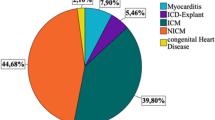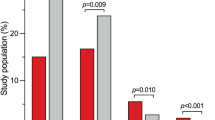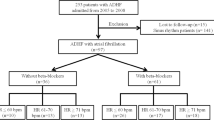Abstract
Heart failure is a deadly disease. Every year, tens of thousands of patients die from this condition, many of them suddenly. Efforts aimed at reducing mortality centered initially on antagonizing the neurohormonal system, which is maladaptively upregulated in response to myocardial failure. Antagonists of the renin–angiotensin–aldosterone and adrenergic nervous systems have reduced the rates of cardiovascular mortality and sudden cardiac death. Antiarrhythmic drug therapy has not fared as well. Consequently, efforts to reduce the risk of sudden death have focused on the use of implantable cardioverter-defibrillators (ICDs). How best to identify patients who will benefit from this invasive and expensive therapy has yet to be clearly determined. In this review, we discuss the effectiveness of ICDs in primary and secondary prevention of sudden death in heart failure patients, and examine the impact that the use of ICDs has had on clinical decision making.
Key Points
-
Antiarrhythmic drugs have failed to reduce the risk of sudden death in patients with heart failure, and implantable cardioverter-defibrillators are becoming the therapy of choice
-
Less than 5% of patients survive sudden cardiac death, but in survivors implantable cardioverter-defibrillators can significantly reduce subsequent events
-
Implantable cardioverter-defibrillators are useful for primary prevention of sudden death in patients with ischemic heart disease, but in those with nonischemic disease the benefits are less clear
-
Cardiac resynchronization therapy can improve outcomes when used with biventricular pacemaker devices
-
Identification of patients at the highest risk needs to be improved, to avoid unnecessary treatment and risk of complications in low-risk patients
This is a preview of subscription content, access via your institution
Access options
Subscribe to this journal
Receive 12 print issues and online access
$209.00 per year
only $17.42 per issue
Buy this article
- Purchase on Springer Link
- Instant access to full article PDF
Prices may be subject to local taxes which are calculated during checkout

Similar content being viewed by others
References
American Heart Association (2005) Heart Disease and Stroke Statistics—2005 Update [http://www.americanheart.org/downloadable/heart/ 1105390918119HDSStats2005Update.pdf] (accessed 27 September 2005)
Cohn JN et al. (1991) A comparison of enalapril with hydralazine-isosorbide dinitrate in the treatment of chronic congestive heart failure. N Engl J Med 325: 303–310
The SOLVD Investigators (1992) Effect of enalapril on mortality and the development of heart failure in asymptomatic patients with reduced left ventricular ejection fractions. N Engl J Med 327: 685–691
Pfeffer MA et al. (1992) Effect of captopril on mortality and morbidity in patients with left ventricular dysfunction after myocardial infarction. Results of the survival and ventricular enlargement trial. The SAVE Investigators. N Engl J Med 327: 669–677
Packer M et al. (1996) The effect of carvedilol on morbidity and mortality in patients with chronic heart failure. U.S. Carvedilol Heart Failure Study Group. N Engl J Med 334: 1349–1355
MERIT-HF Study Group (1999) Effect of metoprolol CR/XL in chronic heart failure: Metoprolol CR/XL Randomised Intervention Trial in Congestive Heart Failure (MERIT-HF). Lancet 353: 2001–2007
Julian DG et al. (1997) Randomised trial of effect of amiodarone on mortality in patients with left-ventricular dysfunction after recent myocardial infarction: EMIAT. European Myocardial Infarct Amiodarone Trial Investigators. Lancet 349: 667–674
Bardy G et al. (2005) Amiodarone or an Implantable cardioverter–defibrillator for congestive heart failure. N Engl J Med 352: 225–237
Gregoratos G et al. (2002) ACC/AHA/NASPE 2002 guideline update for implantation of cardiac pacemakers and antiarrhythmia devices: a report of the American College of Cardiology/American Heart Association Task Force on Practice Guidelines (ACC/AHA/NASPE Committee on Pacemaker Implantation) [http://www.acc.org/clinical/guidelines/pacemaker/pacemaker.pdf] (accessed 27 September 2005)
The Antiarrhythmics versus Implantable Defibrillators (AVID) Investigators (1997) A comparison of antiarrhythmic-drug therapy with implantable defibrillators in patients resuscitated from near-fatal ventricular arrhythmias. N Engl J Med 337: 1576–1583
Connolly SJ et al. (2000) Canadian implantable defibrillator study (CIDS): a randomized trial of the implantable cardioverter defibrillator against amiodarone. Circulation 101: 1297–1302
Kuck KH et al. (2000) Randomized comparison of antiarrhythmic drug therapy with implantable defibrillators in patients resuscitated from cardiac arrest: the Cardiac Arrest Study Hamburg (CASH). Circulation 102: 748–754
Connolly SJ et al. (2000) Meta-analysis of the implantable cardioverter defibrillator secondary prevention trials. AVID, CASH and CIDS studies. Arrhythmias vs Implantable Defibrillator study. Cardiac Arrest Study Hamburg. Canadian Implantable Defibrillator Study. Eur Heart J 21: 2071–2078
Lee DS et al. (2003) Effectiveness of implantable defibrillators for preventing arrhythmias, left ventricular dysfunction, and mortality in the 2 years after myocardial infarction. J Am Coll Cardiol 41: 1573–1582
Moss AJ et al. (2002) Prophylactic implantation of a defibrillator in patients with myocardial infarction and reduced ejection fraction. N Engl J Med 346: 877–883
Buxton AE et al. (1999) A randomized study of the prevention of sudden death in patients with coronary artery disease. Multicenter Unsustained Tachycardia Trial Investigators. N Engl J Med 341: 1882–1890
Bigger JT Jr (1997) Prophylactic use of implanted cardiac defibrillators in patients at high risk for ventricular arrhythmias after coronary-artery bypass graft surgery. Coronary Artery Bypass Graft (CABG) Patch Trial Investigators. N Engl J Med 337: 1569–1575
Cairns JA et al. (1997) Randomised trial of outcome after myocardial infarction in patients with frequent or repetitive ventricular premature depolarisations: CAMIAT. Canadian Amiodarone Myocardial Infarction Arrhythmia Trial Investigators. Lancet 349: 675–682
Doval HC et al. (1994) Randomised trial of low-dose amiodarone in severe congestive heart failure. Grupo de Estudio de la Sobrevida en la Insuficiencia Cardiaca en Argentina (GESICA). Lancet 344: 493–498
Bansch D et al. (2002) Primary prevention of sudden cardiac death in idiopathic dilated cardiomyopathy: the Cardiomyopathy Trial (CAT). Circulation 105: 1453–1458
Strickberger SA et al. (2003) Amiodarone versus implantable cardioverter-defibrillator: randomized trial in patients with nonischemic dilated cardiomyopathy and asymptomatic nonsustained ventricular tachycardia—AMIOVIRT. J Am Coll Cardiol 41: 1707–1712
Kadish A et al. (2004) Prophylactic defibrillator implantation in patients with nonischemic dilated cardiomyopathy. N Engl J Med 350: 2151–2158
Abraham WT et al. (2002) Cardiac resynchronization in chronic heart failure. The MIRACLE study group. N Engl J Med 346: 1845–1853
Cleland JGF et al. for the The Cardiac Resynchronization-Heart Failure (CARE-HF) Investigators (2005) The effect of cardiac resynchronization on morbidity and mortality in heart failure. N Engl J Med 352: 1539–1549
Bristow MR et al.; Comparison of Medical Therapy, Pacing, and Defibrillation in Heart Failure (COMPANION) Investigators (2004) Cardiac-resynchronization therapy with or without an implantable defibrillator in advanced chronic heart failure. N Engl J Med 350: 2140–2150
Bigger JT et al. (1984) The relationships among ventricular arrhythmias, left ventricular dysfunction, and mortality in the 2 years after myocardial infarction. Circulation 69: 250–258
Moss AJ et al. (1996) Improved survival with an implanted defibrillator in patients with coronary disease at high risk for ventricular arrhythmia. Multicenter Automatic Defibrillator Implantation Trial Investigators. N Engl J Med 335: 1933–1940
Bailey JJ et al. (2001) Utility of current risk stratification test for predicting major arrhythmic events after myocardial infarction. J Am Coll Cardiol 38: 1902–1911
Bloomfield DM et al. (2004) Microvolt T-wave alternans distinguishes between patients likely and patients not likely to benefit from implanted cardiac defibrillator therapy: a solution to the Multicenter Automatic Defibrillator Implantation Trial (MADIT) II conundrum. Circulation 110: 1885–1889
Tapanainen JM et al. (2004) Natriuretic peptides as predictors of non-sudden and sudden cardiac death after acute myocardial infarction in the β-blocking era. J Am Coll Cardiol 43: 757–763
La Rovere MT et al. (2001) Baroreflex sensitivity and heart rate variability in the identification of patients at risk for life-threatening arrhythmias: implications for clinical trials. Circulation 103: 2072–2077
Jouven X et al. (2005) Heart-rate profile during exercise as a predictor of sudden death. N Engl J Med 352: 1951–1958
Maisel WH (2005) Safety issues involving medical devices: implications of recent implantable cardioverter-defibrillator malfunctions. JAMA 294: 955–958
Mond HG et al. (2004) The world survey of cardiac pacing and cardioverter defibrillators: calendar year 2001. Pacing Clin Electrophysiol 27: 955–964
Proclemer A et al. (2005) The Italian implantable cardioverter-defibrillator registry. A survey of the national activity during the years 2001-2003. Ital Heart J 6: 272–280
Author information
Authors and Affiliations
Corresponding author
Ethics declarations
Competing interests
The authors declare no competing financial interests.
Rights and permissions
About this article
Cite this article
Winslow, R., Pinney, S. & Fuster, V. Impact of implantable-cardioverter-defibrillator trials on clinical management of patients with heart failure. Nat Rev Cardiol 3, 86–93 (2006). https://doi.org/10.1038/ncpcardio0450
Received:
Accepted:
Issue Date:
DOI: https://doi.org/10.1038/ncpcardio0450



